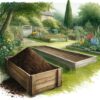How to create an herb garden for tea
There’s an undeniable magic in brewing a cup of herbal tea with leaves handpicked from your garden. This age-old tradition of cultivating and sipping on herbal teas is not only about tantalizing your taste buds but also about embracing the myriad of health benefits these herbs offer. Ready to embark on this herbal journey? Dive deep into our extensive guide on creating and caring for your personalized herbal tea garden, whether you have a sprawling backyard or a cozy balcony.
1. Finding the Perfect Spot
Every herb has its own sun-loving personality. While many flourish in a sun-drenched spot with about 6-8 hours of sunlight, some, especially in hotter regions, thrive in areas with partial shade. Equally important is ensuring your chosen spot has well-draining soil. This is vital as stagnant water can lead to root rot, a common herb garden nemesis.
2. Picking the Right Herbs for Your Garden
Starting with familiar herbs can be comforting, but don’t shy away from experimenting. Here’s a list to get you started:
- Mint: A versatile herb, mint not only refreshes but also aids in digestion.
- Chamomile: These tiny daisy-like flowers are renowned for their calming effects, perfect for a pre-bedtime ritual.
- Lemon Balm: A burst of citrus in every leaf, this herb is known to fight anxiety and insomnia.
- Lavender: Beyond its dreamy fragrance, lavender can calm nerves and ensure a good night’s sleep.
- Rosemary: While great for culinary dishes, a rosemary-infused tea can enhance memory and concentration.
3. Soil Prep: Laying a Strong Foundation
Before planting, it’s crucial to prepare the soil. Herbs thrive in soil that’s rich in organic matter. Enrich your garden bed with compost, aged manure, or worm castings. If container gardening suits your space better, choose pots with ample drainage holes and consider using a premium potting mix tailored for herbs.
4. The Planting Process
While you can start with seeds, beginners might find it easier to begin with young plants. Follow the instructions on seed packets or plant labels, especially regarding depth and spacing. Most herbs prefer a shallow planting depth, with seeds just nestled under the soil’s surface.
5. Nurturing Your Herb Sanctuary
- Watering Routine: Overwatering is a common mistake. It’s best to water when the soil feels dry at a finger’s depth. Using a watering can or hose, ensure a deep soak so the roots receive adequate moisture.
- Regular Pruning: Don’t hesitate to snip off some leaves. Regular trimming promotes a bushier growth, giving you a more bountiful harvest.
- Natural Pest Control: Instead of chemical pesticides, consider natural alternatives. Neem oil, diatomaceous earth, or even introducing beneficial insects like ladybugs can keep pests at bay.
6. The Art of Harvesting and Storage
Timing is everything. For the most robust flavor, pick herbs just before they’re about to flower. The early morning, post-dew and pre-strong sunlight, is the ideal time. Once harvested, you can dry the leaves in a shaded, airy spot or freeze them, perhaps in ice cube trays with a little water, for a chilled, flavor-packed addition to your brew.
7. Perfecting Your Herbal Tea Brew
Whether you prefer fresh or dried herbs, the process is simple. For fresh herbs, a tablespoon per cup is a good rule of thumb. If using dried, a teaspoon should suffice. Pour hot water over the herbs, cover, and let steep. The steeping time varies from 5-10 minutes depending on the herb and personal preference.
8. Exploring the Health Benefits
Beyond the sensory pleasure, herbal teas offer a plethora of health benefits. From aiding digestion and improving sleep to boosting memory and reducing stress, every herb has unique properties. As you sip your homegrown brew, take a moment to appreciate the wellness it brings.
Conclusion
Embarking on the journey of cultivating an herbal tea garden is a holistic experience. It’s a blend of gardening’s therapeutic touch with the health-enhancing qualities of herbs. As you nurture your garden, it, in turn, nurtures you, offering fresh, flavorful, and therapeutic brews cup after cup.
Recent Posts

Coffee Grounds for Plants: Unveiling the Myths and Truths

The 7 Most Popular Succulents to Grow in Your Garden

Cultivating a Healthier You, One Seed at a Time

5 Great Gifts for the Urban Gardener: Enhance Your Green Space with These Must-Have Tools

Understanding “How Much is a Yard of Dirt?” A Comprehensive Guide for Gardeners










